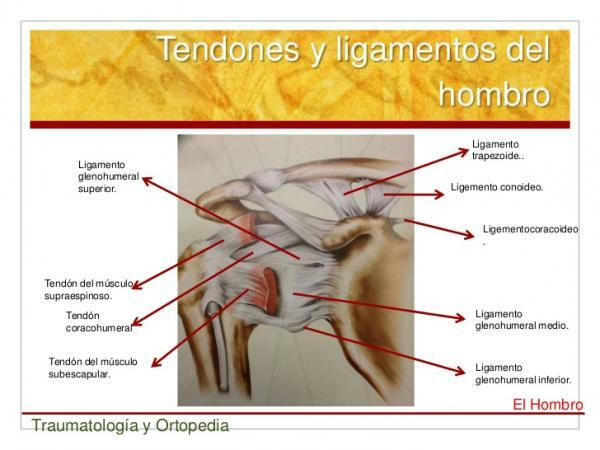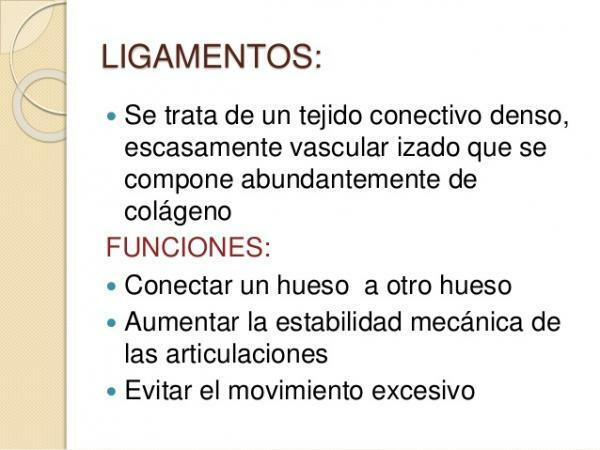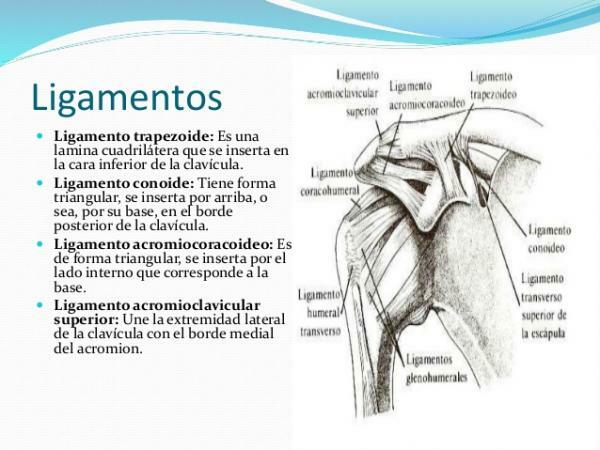All LIGAMENTS of the SHOULDER

Image: Slideshare
The shoulder is a very important joint within the human body as it allows our arms to have great mobility. The shoulder joint is not only made up of the clavicle, scapula and humerus, but Also involved are muscles, ligaments and tendons that are found in the area of union between the arms and the torso. In this lesson from a TEACHER we will focus on learning more about the shoulder ligaments.
Index
- What is a ligament?
- What are the shoulder ligaments?
- The glenohumeral ligaments
- The coracohumeral ligament
- The acromioclavicular ligament
- The coracoacromial ligament
What is a ligament?
Before we start talking about shoulder ligaments it is important that you know what is a ligament. It is a band of dense connective tissue, which although very solid is elastic since its function is to join bones to each other in the whole of a joint. The unique characteristics of the ligament allows movement of the bones, but also prevents the bones from shifting more than they should and may slip out of the correct position within the joint.
If a bone moves out of its proper place, the joint does not function properly and is commonly known as a dislocation. There are other ligaments that have nothing to do with the joints since their function is connect the organs between them or other structures, to keep them in place and that they do not move. An example is the gastro-splenic ligament that connects the stomach and spleen and prevents the latter from displacing.

Image: Slideshare
What are the shoulder ligaments?
We are going to discover the ligaments of the shoulder so that you know our anatomy better. The shoulder is a more or less small joint, that does not have many bones and muscles but it does have a lot of mobility. If you want to know more about it, you can consult the lesson Shoulder joints. In the shoulder joint we can find the following ligaments:
- Glenohumeral ligaments. Depending on their location, they are divided into superior, middle and inferior glenohumeral ligaments, but they are very close together and their function is closely related, so we will discuss them together.
- Acromioclavicular ligament. This ligament joins the clavicle with the acromion.
- Coracohumeral ligament. It joins the coracoid of the scapula with the humerus.
- Coracoacromial ligament. Joins the coracoid process to the acromion.

Image: Slideshare
The glenohumeral ligaments.
There are three glenohumeral ligaments: superior glenohumeral ligament (LGHS), middle (LGHM) and inferior (LGHI). Along with the coracohumeral ligament stabilize the joint and protect it from movements. Due to their nature, both the glenohumeral and coracohumeral ligaments are said to be passive elements of the joint.
In fact, the glenohumeral ligaments, more than ligaments, are considered by many experts in the subject such as thickenings or reinforcements of the anterior capsule of the shoulder for the protection of the herself. The function of the three ligaments will depend on their anatomical position in the joint:
- Higher LGH: limits the external rotation and inferior translation movements of the humeral head.
- Mean LGH: like the previous one, it limits the external rotation but in this case also the previous translation.
- Lower LGH: reinforces the function of the previous two. It is said to be a hammock ligament and its function is to limit external rotation and superior translation and anterior part of the humeral head (anterior part) and limit internal rotation and anterior translation (anterior part later).

Image: Slideshare
The coracohumeral ligament.
The second ligament of the shoulder is the coracohumeral ligament. Like the anterior ligament, it is a passive element of the joint, responsible for its stabilization but its Its function is mainly to support the weight of the arm at rest, against the action of gravity that tends to its decline. This function is also described as acting as an anterior-posterior brake.
The coracohumeral ligament is comprised of two parts, called the anterior and posterior fascicles, which are divided by the biceps tendon that passes between them. The anterior fascicle of the corabohumeral ligament limits the extension of the joint while the posterior fascicle limits flex. The combination of the two fascicles limits the inferior and posterior translation of the head of the humerus at the shoulder.
As we have seen previously, both fascicles of the ligament originate laterally from the coracoid to the humerus, covering superior glenohumeral ligament and eventually inserting into the anterior joint capsule near the junction to the humerus.
The acromioclavicular ligament.
The acromioclavicular ligament acts as a reinforcement for the capsule created in the joint between the clavicle and the acromion. Like the previous one, this ligament is a primary stabilizer against anteroposterior translation of the clavicle and also limits the rotation of the joint as a whole.
When the acromioclavicular ligament is affected, it is called acromioclavicular dislocation. This alteration is quite common.
The coracoclavicular ligament is made up of two units or fascicles called trapezoid ligament Y Conoid ligament. These are quadrilateral and fan-shaped respectively and the Conoid ligament is located more internally than the Trapezoid ligament.

Image: Youtube
The coracoacromial ligament.
The coracoacromial ligament is part of the upper part of the subacromial space. It joins the coracoid processes and acromion of the scapula but it is not an articular ligament therefore it does not provide stability.
It is located where the rotator cuff tendons are arranged and, specifically, this ligament is closely related anatomically to the supraspinatus, so much so that it can condition its deterioration or even its break.
If you want to read more articles similar to Shoulder ligaments, we recommend that you enter our category of biology.
Bibliography
- Ayestarán, A. C., & Gutierrez, R. C. (2015). Anatomy and function of the acromioclavicular joint. Spanish Journal of Arthroscopy and Articular Surgery, 22 (1), 3-10.
- Giménez Belmonte, Dr. D. (s.f) Definition of glenohumeral ligaments. Recovered from https://www.cirugiadelhombro.es/ligamentos-glenohumerales/
- Giménez Belmonte, Dr. D. (s.f) What is the Coracohumeral ligament. Recovered from https://www.cirugiadelhombro.es/ligamento-coracohumeral/
- Sinclair, J. (s.f) Glenohumeral Joint: Functions, Anatomy, Planes and Axes. Recovered from https://www.lifeder.com/articulacion-glenohumeral/



